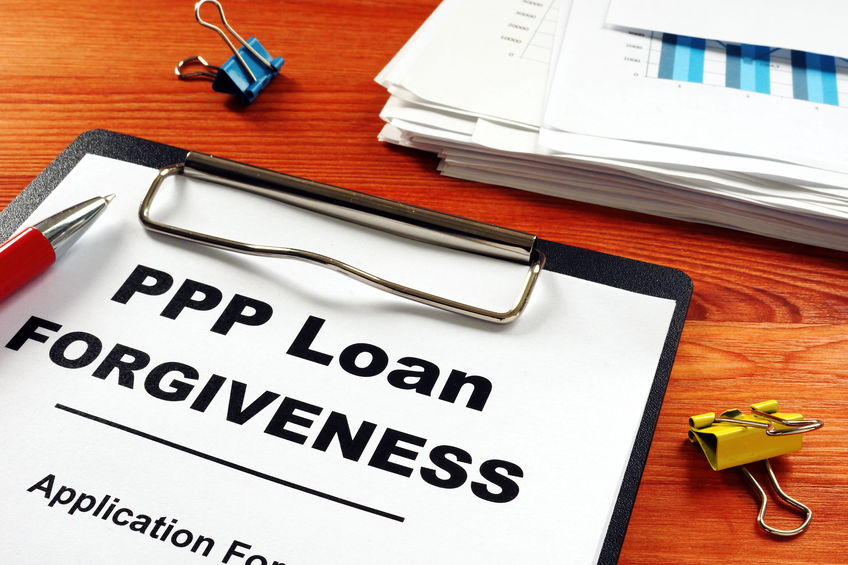(Updated as of June 16, 2020)
The SBA revised the PPP loan forgiveness application and introduced an EZ form for certain qualifying businesses including those who are self-employed and those who did not cut back employee pay by more than 25%.
In addition, for businesses that received the PPP loans before June 5, both forgiveness applications allow the option of calculating forgiveness based on the original eight-week covered period for spending the funds, or the extended 24-week period.
New SBA interim rules also:
- Allow loan forgiveness for payroll costs — including salary, wages, and tips — for up to $100,000 annualized per employee, or $15,385 per individual over the eight-week period. The new interim final rule establishes the 24-week maximum for full loan forgiveness at $46,154 per individual.
- For borrowers with no employees, the maximum loan amount for such borrowers will be 2.5 months of their prior year’s payroll (or self-employment income) for a total of $20,833.
(Updated as of June 5, 2020)
How can you ensure your business receives Paycheck Protection Program (PPP) loan forgiveness? The details are still being worked out, but Congress amended this law earlier this month and the SBA also issued rulings that clarified some important points since you received your loan.
- You will have a longer period of time (five years instead of two) to repay any loan proceeds that aren’t forgiven. It’s likely you signed a two-year note with your lender. Consider asking for a renegotiation of the terms of that previously issued note.
- The eight-week “coverage period” is extended to 24 weeks OR through December 31, 2020, whichever comes earlier. The $100,000 cap remains for now but SHOULD increase as the coverage period is now 16 weeks longer.
- The 25% cap on “non-payroll expenses” has increased to 40%. However, it appears that they introduced a cliff to get the proceeds, in that it states, “to receive loan forgiveness…an eligible recipient shall use at least 60% of the covered loan amount for payroll costs.” Does this mean that if the borrower only spends 50% of the proceeds on payroll, then NONE of the proceeds are forgivable? Hopefully, the SBA will clarify and correct this.
- The June 30, 2020, date to replace full-time equivalent (FTE) enrollment has been changed to December 31, 2020.
- Businesses that remain partially or fully closed through the end of the year will get new relief. Forgiveness will NOT be reduced when a borrower experiences a loss of FTEs if the borrower, in good faith, is able to document ANY of the following:
- There was an inability to rehire individuals who were employees of the eligible recipient on February 15, 2020,
- There was an inability to hire similarly qualified employees for unfilled positions on or before December 31, 2020, or
- There was an inability to return to the same level of business activity as such business was operating at before February 15, 2020, due to compliance with requirements established or guidance issued by the Secretary of Health and Human Services, the Director of the Centers for Disease Control and Prevention, or the Occupational Safety and Health Administration during the period beginning on March 21, 2020, and ending December 31, 2020, related to the maintenance of standards for sanitation, social distancing, or any other worker or customer safety requirement related to COVID– 19. (THIS IS VERY IMPORTANT: It basically provides that if the world is such that on December 31, 2020, restaurants and bars, for example, are unable to fully open due to government orders, any loss in FTEs resulting from such restrictions should NOT be taken into account in computing a required reduction in the forgivable amount.)
- There was an inability to rehire individuals who were employees of the eligible recipient on February 15, 2020,
Before these June changes were passed, our own Steven Bankler alongside his colleagues John Dini, CExP, CEPA and James Rosenblatt, JD, MBA answered business owners’ questions during a PPP Roundtable webinar series hosted nationally by XPX Exit Planning Exchange.
These two webinars cover several important points about PPP loan forgiveness including what happens when employees decline to return to work when they’re asked. The webinars also provide tips on:
- Whether certain benefits and bonuses can be included as part of the forgiveness application.
- How to track qualified expenses including the importance of keeping PPP funds in a separate bank account for better tracking.
- The steps needed to receive 100% forgiveness on the loan.
- When to file your forgiveness application, what’s included, and what needs to happen before you can file.
- Who may be audited and what the audit will look like.
While some of the information included in these webinars—particularly when it comes to deadlines and forgiveness caps—is outdated due to the recent changes, they remain very helpful in providing a general overview the steps needed to receive the full forgiveness that you deserve. Click on the following links to view:
May 22, 2020, XPX SAN ANTONIO – PPP ROUNDTABLE
June 3, 2020, XPX SAN ANTONIO – PPP ROUND TABLE CONTINUED
You can connect with Steven, John, and James through the XPX Exit Planning San Antonio chapter. Remember that the rules are changing and being clarified consistently. For up-to-date information on PPP loan forgiveness and how it might relate to your unique situation, feel free to contact us.

